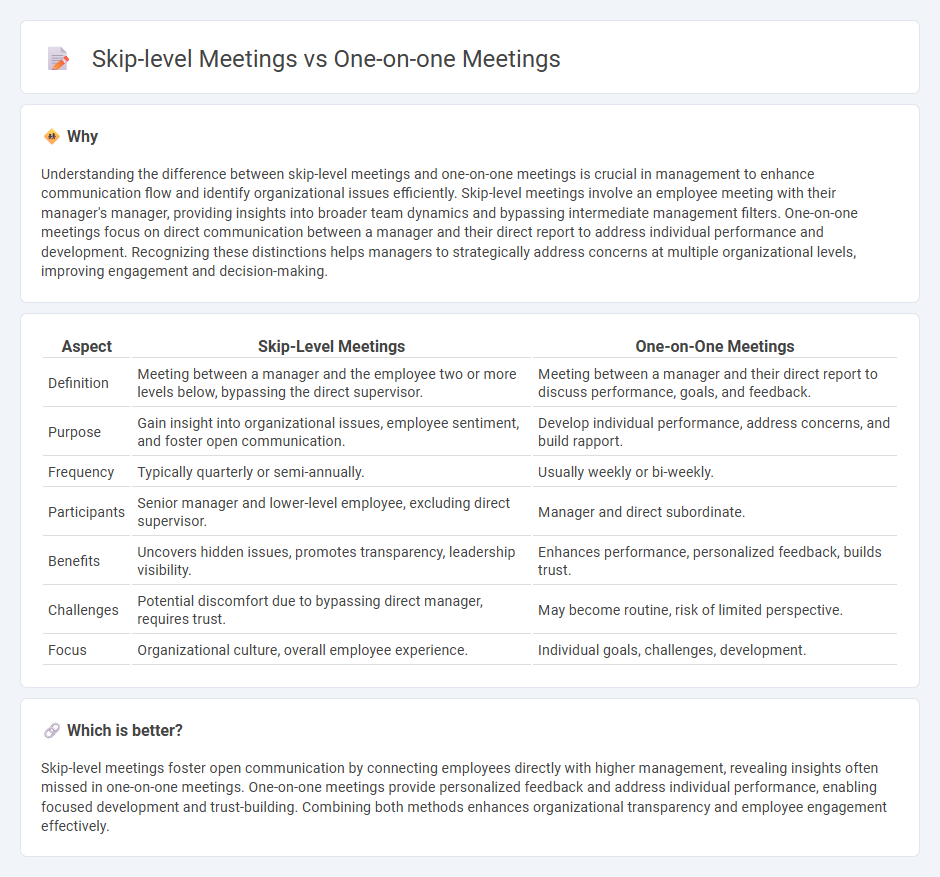
Skip-level meetings facilitate direct communication between employees and senior leaders, bypassing immediate supervisors to uncover insights often missed in traditional hierarchies. One-on-one meetings focus on personalized feedback and development between managers and their direct reports, enhancing individual performance and trust. Explore how integrating both meeting types can optimize organizational communication and leadership effectiveness.
Why it is important
Understanding the difference between skip-level meetings and one-on-one meetings is crucial in management to enhance communication flow and identify organizational issues efficiently. Skip-level meetings involve an employee meeting with their manager's manager, providing insights into broader team dynamics and bypassing intermediate management filters. One-on-one meetings focus on direct communication between a manager and their direct report to address individual performance and development. Recognizing these distinctions helps managers to strategically address concerns at multiple organizational levels, improving engagement and decision-making.
Comparison Table
| Aspect | Skip-Level Meetings | One-on-One Meetings |
|---|---|---|
| Definition | Meeting between a manager and the employee two or more levels below, bypassing the direct supervisor. | Meeting between a manager and their direct report to discuss performance, goals, and feedback. |
| Purpose | Gain insight into organizational issues, employee sentiment, and foster open communication. | Develop individual performance, address concerns, and build rapport. |
| Frequency | Typically quarterly or semi-annually. | Usually weekly or bi-weekly. |
| Participants | Senior manager and lower-level employee, excluding direct supervisor. | Manager and direct subordinate. |
| Benefits | Uncovers hidden issues, promotes transparency, leadership visibility. | Enhances performance, personalized feedback, builds trust. |
| Challenges | Potential discomfort due to bypassing direct manager, requires trust. | May become routine, risk of limited perspective. |
| Focus | Organizational culture, overall employee experience. | Individual goals, challenges, development. |
Which is better?
Skip-level meetings foster open communication by connecting employees directly with higher management, revealing insights often missed in one-on-one meetings. One-on-one meetings provide personalized feedback and address individual performance, enabling focused development and trust-building. Combining both methods enhances organizational transparency and employee engagement effectively.
Connection
Skip-level meetings foster direct communication between senior managers and employees, bypassing immediate supervisors to gain unfiltered insights. One-on-one meetings maintain regular, personalized dialogue between managers and their direct reports, focusing on performance and development. Together, these meetings enhance organizational transparency, trust, and alignment by addressing issues at multiple hierarchical levels.
Key Terms
Direct Reporting
One-on-one meetings center on direct reporting relationships, fostering clear communication, personalized feedback, and goal alignment between managers and their immediate subordinates. These sessions promote trust and address individual challenges, enhancing employee development and performance management. Explore more to understand which meeting type best suits your organizational needs.
Communication Flow
One-on-one meetings foster direct communication between managers and employees, enhancing relationship building and personalized feedback. Skip-level meetings bypass immediate supervisors, offering leaders insights into team dynamics and uncovering hidden challenges that might not surface in regular one-on-ones. Explore the benefits and best practices of both meeting types to optimize your organizational communication flow.
Organizational Hierarchy
One-on-one meetings strengthen direct communication between managers and employees, fostering individual performance and addressing immediate concerns within the organizational hierarchy. Skip-level meetings bypass direct managers, enabling senior leaders to gain insights into team dynamics and uncover systemic issues that may not surface in traditional reporting lines. Explore how leveraging both meeting types can optimize organizational communication and hierarchy effectiveness.
Source and External Links
Effective one-on-one meetings - This resource provides insights into utilizing one-on-one meetings as a cornerstone for open communication and employee development between managers and team members.
One on One Meetings with Employees - This guide outlines best practices for conducting one-on-one meetings, including setting agendas and checking in on employee well-being and development.
Manager Best Practices: One-on-One Meetings - This article discusses the benefits and structure of regular one-on-one meetings, emphasizing their role in building trust and employee engagement.
 dowidth.com
dowidth.com